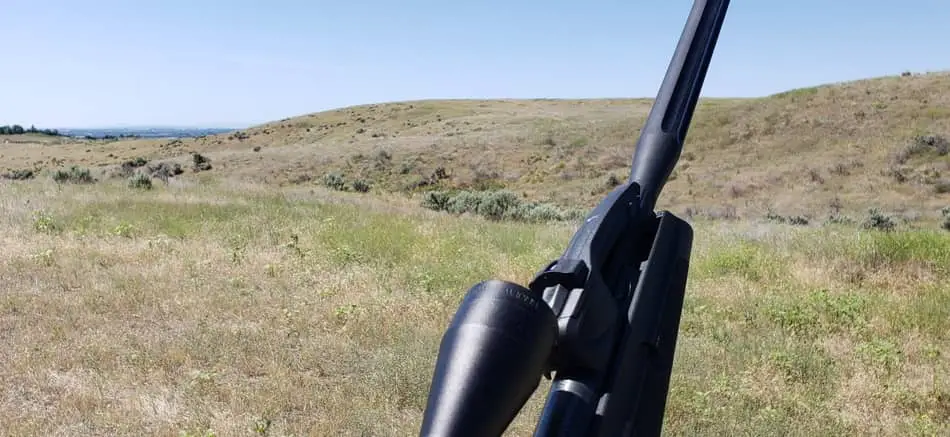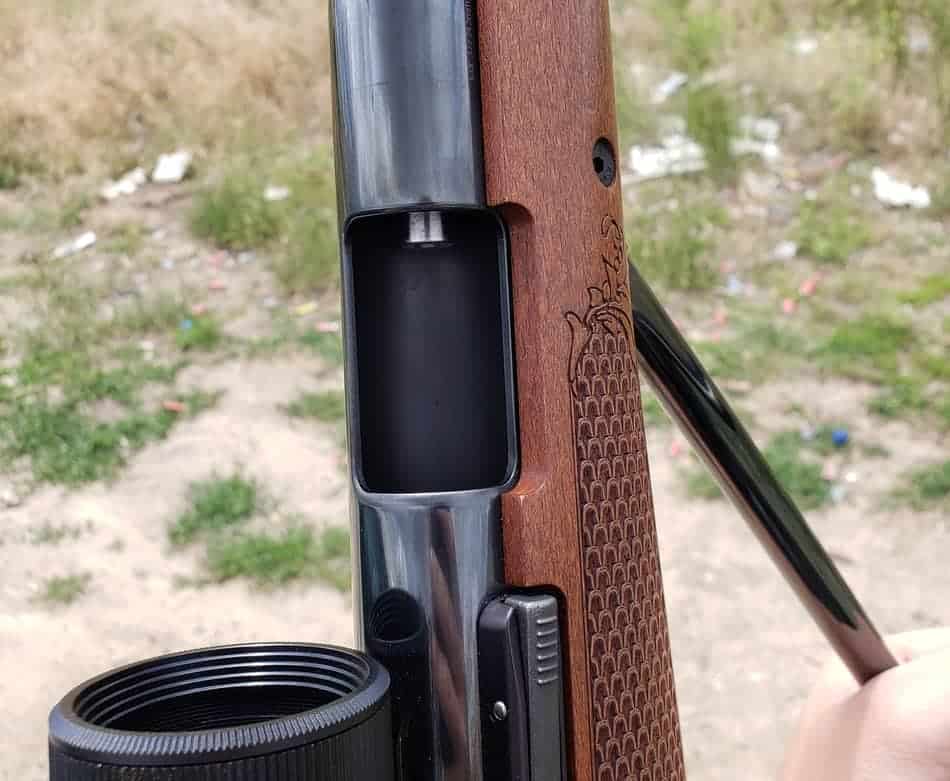
Pellet guns come in many shapes and sizes: break barrel, PCP, multi-pump, each with its own positives and negatives. Maybe you heard of these and are left wondering about the accuracy of your break barrel airgun.
Many break barrel airguns are very accurate, able to shoot a 1″ or smaller group at 25 yards. However, the moving barrel design can introduce errors that can compromise accuracy, but the greatest variable will be one’s own skill as a shooter.
Before we delve too deep into this topic, it is worth noting that some of the most accurate pellet guns have been break barrels. If your break barrel airgun is well made, then then accuracy will not be a huge concern to you. That said, most break barrel airguns do have a small reduction in accuracy.
If you are here to learn more about break barrel airguns and want to know what kinds of things will affect the accuracy of your airgun, you are at the right place.
What kind of Accuracy Can I Expect?
This will depend greatly on your own skill as a marksman. Yes, if you are not using a higher-end springer, you can expect some decrease in accuracy, but don’t let that hold you back.
As we sad before, springers are capable of putting groups together within an inch at 25 yards. Some higher-end PCP’s will be able to do half inch groups at 25 yards. I’ve seen a three inch wide board hit by a break barrel gun at 75 yards though, so I would not worry too much about your break barrel gun. The biggest variable will be your own skill at shooting.
Some airgunners actually like to practice more with these types of guns because learning to handle the quirks of break barrels lend increased skill to a determined marksman.
How does the Build of the Gun Affect My Accuracy?

This is actually a really fun question to answer for me. There are a lot of factors that can play into the accuracy of a gun. Rifling, feet per second, pellet size, weight, and shape. A break barrel springer gun has more moving parts than other types of airguns do, which plays a part.
As a general rule of thumb in any type of mechanical construction, the fewer moving parts the better. The parts that move on a break barrel springer that contribute the most to accuracy or lack thereof are the barrel and the spring. Surprise surprise.
Your barrel moves each time you load a shot. To load a break barrel gun, you would grab the end of the barrel and pull it down, swinging it as much as you can. This both compresses the spring in the gun and opens the breech for you to load your pellet into.
When you close the barrel, it will click when put back into place. The differences between where the barrel started and where it ended are very small, bare millimters at most, but do exist. The further the pellet travels from its starting point in the barrel, the more apparent the discrepancy will be.
Like an airplane that is just one degree off of course, the pellet will not fly as true as it could have been because of a variable that you might have very little control over.
We if you are a good marksman, you will be able to hit what you are aiming at at a reasonable distance, and in fact, we are only talking generally about break barrels right now.
Some of the most accurate airguns have been break barrel airguns. Sig Sauer has a gun with a newer design that keeps the barrel moving back into place much more consistently, improving its accuracy.
has a gun with a newer design that keeps the barrel moving back into place much more consistently, improving its accuracy.
Another thing you may want to know about break barrel airguns that play into their accuracy is how they get the pellet to move. Most of these guns depend on you doing all of the hard work, compressing a spring as you load your pellet into the barrel.
When your barrel is opened all of the way, that spring locks in place inside of your gun, just waiting for you to tell it what to do. Unfortunately, is is only capable of doing one thing, and that one thing is jumping forward really fast when you pull the trigger, which pulls the restraints away from the spring.
The spiral shape of the spring is not very good at moving air by itself, so they come equipped with a hammer like head. This handy piece, called a plunger, catches the air inside the chamber better than your mom caught you that one time you thought she was asleep, and you tried to sneak out.
The spring then forces this trapped air forward and out the barrel, pushing the pellet ahead of it. Having accomplished its job, the spring sits there until you force it back into position by loading another pellet into the gun.
This method of using the spring works very well, but because the spring has a lot of weight, as it jumps forward, it pushes the gun around quite a bit. This is why you will often hear about spring airguns having more recoil than most airguns do. Where they depend upon small valves that just sit there and don’t do anything, springers don’t, making them move more.
There are some spring airguns that ditch the spring, instead using a device that goes by many different names, but can be safely called a gas ram. A gas ram does the exact same thing as the spring does, except it is a small cylinder of compressed air that acts like a spring.
Because the gas ram is powered by compressed air, it weighs so much less than a normal spring does, and because it weighs so much less, this guy is able to the spring’s job just as well, but without nearly as much recoil, making your springer more accurate.
Gas rams are a newer development on the market, but have been around for a while. Usually you will be able to find out if your break barrel has a spring or a gas ram before you buy. Fortunately, these gas ram guys are made to take over the job, so if you have a springer, and want to switch over to a gas ram, there is a good chance that you can replace the part yourself.
Find out about your gun before you start taking it apart though.
Are There Techniques that Can Help Improve my Accuracy With a Springer?
There are techniques known in the airgunning community to help improve accuracy when aiming with a spring powered airgun. Hold the gun looselly, and rest the grip in the open palm of your hand.
Often times, when you shoot an airgun or a normal firearm, you want to grip the thing hard to keep it from moving a lot. If you try to employ that technique when using a springer airgun, you get some compatibility issues.
You see, when the spring in an airgun moves, it moves the same way everytime, and its motion is contained within the gun, while residual energy from the fire reverberates through the spring.
The method that a lot of experienced airgunners use to help fix this problem sounds counter intuitive, but what you need to do is let the gun do its thing. Holding the gun loosely, while letting it rest in your forward hand’s open palm allows the gun to move how it will move, and dramatically improves your accuracy.
Do I Need to Clean My Airgun to Maintain Accuracy?
Rarely, if ever, do airguns need cleaning. Regular cleaning is not really required, as there is no real build up inside the barrel. Any lead that is left on the surface of the barrel is regularly removed by the next pellet to be sent careening down the barrel.
If you are experiencing accuracy issues for no apparent reason, cleaning your airgun may fix it, but that will not happen often. Obviously, if you get mud or dirt or grime inside the barrel for any of various reasons, clean it out.
If you do ever need to clean your gun out, it would be best to use a plastic rod with a felt tip and a manufacturer recommended cleaning oil. There are such thing as cleaning pellets, but these are not always recommended. They are small pieces of felt shaped like pellets that fit into the barrel of your gun.
They however are not always effective at cleaning your gun and have been known to get stuck in the barrel or the suppressor.
What Other Maintenance Do I Need to Maintain Accuracy?
Even though you are fortunate enough to not need to worry about cleaning your gun regularly, there are some things that you should do to keep your gun in good working order.
Do check reguarly the screws on your break barrel. Over process of time, small jostling and movements can add up and slowly loosen the fastenings holding your gun together in one piece. Often, if you are experiencing an accuracy issue, the screws in your stock may need tightening.
The intense movement of the spring jumping around in the gun has been known to loosen low quality scopes and sometimes even knock them off of the gun entirely. This happened to me the other week, which was disappointing because the gun had no other optics on it, cutting my shooting time that day short. It was an easy fix, but you need to be aware of that.
Airgun makers also suggest not having your spring cocked for too long at one time, usually no more than an hour, though some have been known to be compressed for several days at a time without issue. The idea here is that if a mechanical spring stays compressed for too long, it might lose some of its energy. Gas rams do not need to worry about this.
Are There Spring Airguns Without Break Barrels?

There are spring airguns that do not have break barrel actions. These are known as underlever or sidelever air guns, and have fixed barrels with a sliding breech.
As you could probably guess, these guns usually come in two flavors; sidelever and underlever. These airguns differ from break barrel guns in really only one way, and I believe you are smart enough to guess by now what it is. Because the barrel of these guns does not move, you do not need to worry too much about how that will affect your shooting.
If you are using a springer, do be mindful of how the gun behaves when the spring moves, otherwise, that will throw your accuracy.
